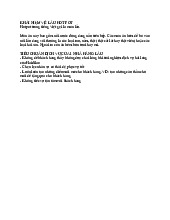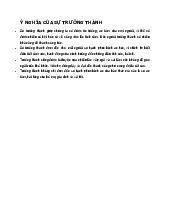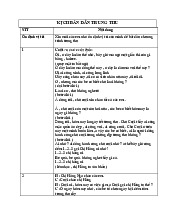






Preview text:
- Khái niệm Fast fashion: Overview / Definition of fast fashion
*Overview / Definition of fast fashion
What is the concept of fast fashion?
Fast fashion - Fast fashion is a word for (low-cost) cheap, trendy clothes, sewn
very quickly by popular and affordable fashion brands based on ideas and
designs from fashion collections of famous brands. Fast fashion is also a
fashion production and consumption model, where products are produced
and sold with high frequency, low prices and time from design to
production and sale is very fast. This model is becoming increasingly
popular in the fashion industry, especially with the development of
technology and the internet.
Thời trang nhanh - Fast fashion là từ để chỉ các loại quần áo có giá thành rẻ, được
may rất nhanh chóng bởi các thương hiệu thời trang bình dân, thông dụng dựa
trên ý tưởng, thiết kế từ các bộ sưu tập thời trang của các thương hiệu nổi tiếng.
Thời trang nhanh cũng là một mô hình sản xuất và tiêu thụ thời trang, nơi sản
phẩm được sản xuất và bán ra với tần suất cao, giá cả thấp và thời gian từ khi
thiết kế đến khi sản xuất và bán ra rất nhanh. Mô hình này đang ngày càng trở
nên phổ biến trong ngành công nghiệp thời trang, đặc biệt là với sự phát triển của
công nghệ và mạng internet.
( Fast fashion can be defined as cheap, trendy clothing that samples ideas from
the catwalk or celebrity culture and turns them into garments at breakneck speed
to meet consumer demand. The idea is to get the newest styles on the market as
fast as possible, so shoppers can snap them up while they are still at the height of
their popularity and then, sadly, discard them after a few wears
➔Thời trang nhanh có thể được định nghĩa là quần áo hợp thời trang, giá rẻ,
lấy mẫu ý tưởng từ sàn catwalk hoặc văn hóa của người nổi tiếng và biến
chúng thành quần áo với tốc độ chóng mặt để đáp ứng nhu cầu của người
tiêu dùng. Ý tưởng là đưa những kiểu dáng mới nhất ra thị trường càng
nhanh càng tốt, để người mua hàng có thể chộp lấy chúng khi chúng vẫn
đang ở đỉnh cao của sự nổi tiếng và sau đó, thật đáng buồn, lại loại bỏ
chúng sau một vài lần mặc.)
⇨ Fast fashion is a word for cheap, trendy clothing that samples ideas from the
catwalk or celebrity culture, sewn very quickly by popular and affordable fashion brands
- Nguyên nhân xuất hiện: - How did fast fashion happen?
- To understand how fast fashion came to be, we need to rewind a bit. Before the
1800s, fashion was slow. You had to source (find) your own materials like wool or
leather, prepare them, weave them, and then make the clothes.
- The Industrial Revolution introduced new technology—like the sewing machine.
Clothes became easier, quicker, and cheaper to make. Dressmaking shops
emerged (Appeared) to cater to the middle classes.
- Many of these dressmaking shops used teams of garment workers or home
workers. Around this time, sweatshops emerged, along with some familiar safety
issues. The first significant garment factory disaster was when a fire broke out in
New York’s Triangle Shirtwaist Factory in 1911. It claimed the lives of 146
garment workers, many of whom were young female immigrants.
- By the 1960s and ’70s, young people were creating new trends, and clothing
became a form of personal expression, but there was stil a distinction between high fashion and high street.
- In the late 1990s and 2000s, low-cost fashion reached a peak. Online shopping
took off, and fast fashion retailers like H&M, Zara, and Topshop took over the high
street. These brands took the looks and design elements from the top fashion
houses and reproduced them quickly and cheaply. With everyone now able to
shop for on-trend clothes whenever they wanted, it’s easy to understand how the phenomenon caught on.
- (Để hiểu thời trang đã phát triển nhanh như thế nào, chúng ta cần tua lại một
chút. Trước những năm 1800, thời trang rất chậm chạp. Bạn phải tự tìm nguồn
nguyên liệu như len hoặc da, chuẩn bị, dệt và sau đó may quần áo.
- Cuộc cách mạng công nghiệp đã giới thiệu công nghệ mới—như máy
khâu. Quần áo trở nên dễ dàng hơn, nhanh hơn và rẻ hơn. Các cửa hàng may
mặc nổi lên để phục vụ tầng lớp trung lưu.
- Nhiều xưởng may quần áo này sử dụng đội công nhân may mặc hoặc công nhân
tại nhà. Vào khoảng thời gian này, các xưởng bóc lột sức lao động xuất hiện
cùng với một số vấn đề an toàn quen thuộc. Thảm họa nghiêm trọng đầu tiên ở
nhà máy may mặc là khi một vụ hỏa hoạn xảy ra ở Nhà máy Triangle Shirtwaist ở
New York vào năm 1911. Nó đã cướp đi sinh mạng của 146 công nhân may
mặc, nhiều người trong số họ là những phụ nữ trẻ nhập cư .
- Đến những năm 1960 và 70, giới trẻ tạo ra những xu hướng mới và quần áo trở
thành một hình thức thể hiện cá nhân, nhưng vẫn có sự phân biệt giữa thời trang
cao cấp và thời trang đường phố.
- Vào cuối những năm 1990 và 2000, thời trang giá rẻ đạt đến đỉnh cao. Mua sắm
trực tuyến phát triển và các nhà bán lẻ thời trang nhanh
như H&M , Zara và Topshop đã chiếm lĩnh thị trường. Những thương hiệu này
lấy kiểu dáng và yếu tố thiết kế từ các hãng thời trang hàng đầu rồi tái tạo chúng
một cách nhanh chóng và rẻ tiền. Với việc mọi người giờ đây có thể mua sắm
quần áo hợp xu hướng bất cứ khi nào họ muốn, thật dễ hiểu hiện tượng này đã xảy ra như thế nào.) - -
In the late 1990s and 2000s, low-cost fashion reached a peak. Online shopping
took off, and fast fashion retailers like H&M, Zara, and Topshop took over the
high street. These brands took the looks and design elements from the top
fashion houses and reproduced them quickly and cheaply. With everyone now
able to shop for on-trend clothes whenever they wanted, it’s easy to understand
how the phenomenon caught on. – trở nên phổ biến.
(Vào cuối những năm 1990 và 2000, thời trang giá rẻ đạt đến đỉnh cao. Mua sắm trực
tuyến phát triển và các nhà bán lẻ thời trang nhanh như H&M , Zara và Topshop đã
chiếm lĩnh thị trường. Những thương hiệu này lấy kiểu dáng và yếu tố thiết kế từ các
hãng thời trang hàng đầu rồi tái tạo chúng một cách nhanh chóng và rẻ tiền. Với việc
mọi người giờ đây có thể mua sắm quần áo hợp xu hướng bất cứ khi nào họ muốn,
thật dễ hiểu hiện tượng này đã xảy ra như thế nào.)
Fast fashion brands caught on to meet the increasing fashion needs of people
and at the same time to catch up with trends each year.
Outfits from fast fashion brands are now considered trendy, top-notch sold in
many places, many people with the desire to express their own style will find
different types of clothing that fit the trend and match this trend.
(Tại sao thời trang nhanh lại xảy ra?
Các thương hiệu thời trang nhanh bắt kịp để đáp ứng nhu cầu thời trang ngày
càng cao của con người, đồng thời bắt kịp xu hướng, xu hướng mỗi năm.
Trang phục đến từ các thương hiệu thời trang nhanh giờ đây được xem là những
set đồ thời thượng, đỉnh cao được bày bán ở nhiều nơi, vô số người với mong
muốn thể hiện phong cách của mình sẽ tìm thấy những bộ trang phục thời
thượng, thời thượng này)
- Đặc điểm – dấu hiệu nhận biết: Signs of a Fast Fashion Brand - How to spot a fast fashion brand?
Some criteria to identify a fast fashion brand include:
Does the brand have a variety of fashion styles and is it catching up and responsive to trends?
The time it takes to launch trendy fast fashion collections on sale is much
shorter than the time it takes for the outfits to appear on the catwalk.
Goods sold are limited in quantity because they only produce a certain quantity
sold in a short period of time.
The material used to make these costumes is usually quite cheap, so the outfit degrades quite quickly
(Có thể cho các bạn thử chọn những tiêu chí nhận biết đâu là ttn)
(Dấu hiệu nhận biết một thương hiệu fast fashionMột số tiêu chí để nhận biết một
thương hiệu thời trang nhanh hay không bao gồm:
Thương hiệu đó có đa dạng phong cách thời trang không và có bắt kịp, nhanh
nhạy với các trend thịnh hành? -- Thousands of styles, which touch on al the latest trends
Thời gian để ra mắt các bộ sưu tập fast fashion hợp trend được bày bán ngắn hơn
nhiều so với thời gian của các bộ trang phục trên sàn catwalk.
Hàng hóa bán ra có sự giới hạn về số lượng do họ chỉ sản xuất một số lượng nhất
định bán trong một khoảng thời gian ngắn.
Chất liệu may các loại trang phục này thường có giá thành khá rẻ vì vậy bộ trang
phục khá nhanh xuống cấp) - Cheap, low quality materials like polyester,
causing clothes to degrade after just a few wears and get thrown away
Ví dụ: Một sản phẩm biểu diễn trên sàn Runway, chỉ sau đó khoảng 12 – 24h trên
thị trường lập tức xuất hiện một sản phẩm mẫu mã kiểu dáng tương tự. Những
sản phẩm này có mức giá “mềm” hơn gấp nhiều lần so với sản phẩm trên sàn
Runway trước đó. Và đó được gọi là thời trang nhanh.
• It plays into the idea that outfit repeating is a fashion faux pas and that if
you want to stay relevant, you have to sport the latest looks as they happen.
It forms a key part of the toxic system of overproduction and consumption
that has made fashion one of the world’s largest polluters.
• Nó có ý tưởng rằng việc lặp lại trang phục là một lỗi thời trang và nếu bạn muốn
duy trì sự phù hợp, bạn phải diện những kiểu dáng mới nhất khi chúng xuất hiện.
Nó tạo thành một phần quan trọng của hệ thống sản xuất và tiêu thụ quá mức
độc hại đã khiến thời trang trở thành một trong những nguyên nhân gây ô
nhiễm lớn nhất thế giới
Câu nói này của nhà thiết kế người Anh Vivienne Westwood nói lên điều đó hay
nhất: “ mua ít hơn, chọn kỹ, sử dụng lâu dài ”.
- Ưu điểm – Advantages/ Positive Impact:
- Helps consumers have average income have the opportunity to refresh their
wardrobes with cheap items and not feel regretful when they don't use them
much. / It’s cheap and affordable, so the middle-income consumers can buy
to catch up with trends and not feel regretful so much. ? Because of the
many designs and low prices, it easily attracts many customers and brings
huge profits. - Chính vì mẫu mã nhiều và giá thành thấp nên dễ dàng thu hút
nhiều đối tượng khách hàng và mang đến lợi nhuận khủng.
- The production cost for “instant noodle fashion” will be cheaper than sustainable fashion.
Chi phí sản xuất dành cho ngành hàng thời trang mì ăn liền sẽ rẻ hơn so với thời trang bền vững.
- Provide jobs: The fast fashion industry provides a large number of jobs for
workers worldwide, especially in developing countries. This can help
improve the economic and living conditions of these workers.
Cung cấp việc làm: Ngành thời trang nhanh cung cấp một lượng lớn việc làm cho
người lao động trên toàn thế giới, đặc biệt là ở các nước đang phát triển. Điều này
có thể giúp cải thiện điều kiện kinh tế và đời sống của những người lao động này.
- Create fashion products that match trends: Fast fashion helps create fashion
products that match trends more quickly and flexibly, helping fashion
brands grow and compete with each other.
Tạo ra những sản phẩm thời trang phù hợp với xu hướng: Thời trang nhanh giúp
tạo ra những sản phẩm thời trang bắt kịp xu hướng một cách nhanh chóng và linh
hoạt hơn, giúp các thương hiệu thời trang phát triển và cạnh tranh với nhau
- Because the designs are constantly changing, it is easier to attract
customers, without worrying about the problem of outdated inventory.
Chính vì những mẫu mã được thay đổi liên tục, dễ dàng thu hút khách hàng hơn,
không lo ngại vấn đề lỗi mốt tồn kho.
- Increasing resource efficiency: Fast fashion manufacturers have sought to
increase resource efficiency by using recycled materials, optimizing
production and transportation processes, and utilization. renewable energy source.
Tăng hiệu quả sử dụng nguồn lực: Thời trang nhanh các nhà sản xuất đã tìm cách
tăng hiệu quả sử dụng tài nguyên bằng cách sử dụng vật liệu tái chế, tối ưu hóa
quy trình sản xuất và vận chuyển cũng như tận dụng. nguồn năng lượng tái tạo
- However, these positive impacts must also face the negative impacts of fast
fashion on the environment and society. Therefore, to ensure the sustainable development of the fashion
- Thực trạng: The Current State of Fast Fashion
Fast fashion is becoming a large and rapidly growing industry globally. There are
many fast fashion brands such as Zara, H&M, Forever 21, and Fashion Nova,
among others. These brands have become household names, with stores located
in shopping districts, malls, and online platforms




